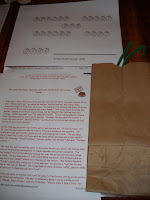
My mother gave me something interesting this spring - a bunch of loofah seeds. Loofah's are those little scrubby things often seen at the stores with a string tied round the top. Most people use them in the shower because they make a great exfoliator. They are as prolific as cucumbers or zucchini when growing, so they make a great homeschool project. (SINCE THIS ISN'T TECHNICALLY A LESSON, I WILL PUT THE WORD LESSON IN PARENTHESES NEXT TO ANY GOOD IDEA FOR USING A LOOFAH TO TEACH) We are still in the process of learning about them, but I thought I'd post on how to grow them so you can
order seeds for the spring.Loofah does great right in the ground, but you can also start them indoors in tiny pots. (LESSON) The one plant we have was started in a peat pot. Honestly, I kept it in the pot too long and will experiment with ground seeding this next spring. However, it has not failed to flourish. (See picture above.) In fact, it started taking over my house. Climbing up the brick wall, strangling out my smaller bushes near it, and attaching itself to my front window screens. Next year, we will make sure we have a large trellis or use our back deck to give it more room to climb. While it can climb up a brick wall, once the loofah begin to grow the weight will rip it from the wall. (LESSON)
Loofah seeds are medium-sized black seeds, and one loofah can give you up to 30 seeds or more. That's why you only need to get your hands on one to have enough seeds to last a lifetime.

It will take a few weeks before your vine grows strong and healthy. Once it does, it will start to branch out and need quite a bit of trellis support. Unfortunately, ours is only supported a few feet, so most of it is lying on the ground. We will fix that next year. Once it starts to grow, you will see little green cluster buds start to form. Those clusters will bloom into pretty yellow flowers that attract a ton of bees for pollination. (LESSON) Once the flowers dry up, a baby loofah will begin to grow. When they first start out, they resemble a certain part of the male anatomy. (POSSIBLE LESSON?) If you notice these all over your vine, you're going to have a great harvest. Here's a pic that shows cluster buds, a flower, and the baby loofah:

Our plant has been in the ground since mid-August, and we noticed our first flowers and baby loofahs about 3 weeks after transplanting it. The loofahs we currently have on the vine look like this:


As you can see, they look very much like a cucumber. I have read a variety of advice about harvesting these vegetables. Most say to wait until the loofah is brown or yellow and dried out. This means the fibers inside have dried out and you can peel it, lay it in the sun for a day, and use it. There are people who say you can pick them green, especially if you notice that they're beginning to get ground rot or mildew, and let them dry out on your porch. Others say you can pick and peel them green, but you will need to milk the loofah before it will begin to dry out. (INTERESTING LESSON) The only method we've done is to peel a dried loofah. The skin is crusty and peels away in chunks and flakes. We shook out the seeds and this is what we had left:

I personally don't care for the earthy smell of it, but I do like to cut it into chunks and use it as a dish scrubber. We are going to keep our loofah vine until the first frost kills it. I'll post an update about our harvesting/milking/peeling/drying methods then. I hope you've enjoyed this interesting vegetable and will consider planting one just for the fun learning experience. Happy Homeschooling!


















